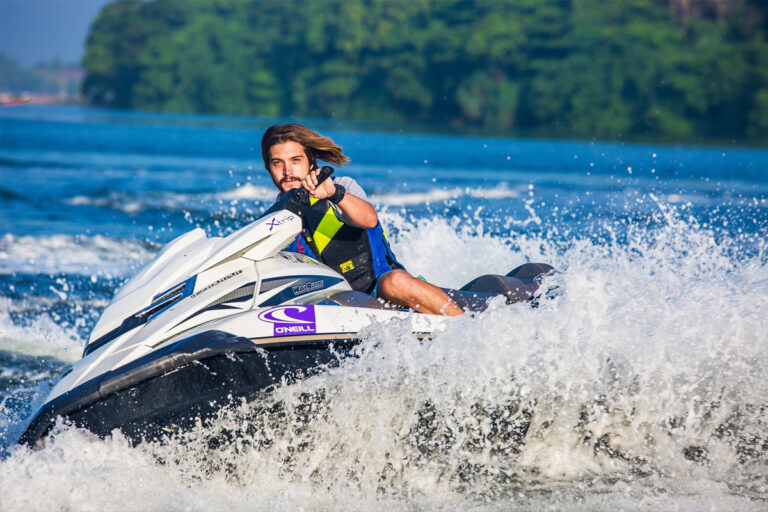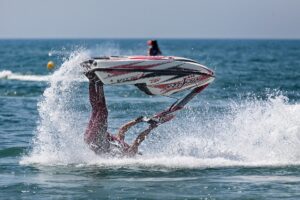Is it your first time voyaging with us? No need to worry – we’re here there ensure you have a fun, safe experience. Lets go over the following before your day on the water:
General Operation
- The Personal Water Craft (PWC) you are renting is a high-performance boat, not a toy, and as such you have to carefully observe and follow the instructions and safety rules outlined here.
- Make sure to ensure you have enough gas for your return back to the rental livery. A good rule of thumb regarding fuel use is
- one-third out, one-third back in, and one-third in reserve.
Safety Equipment
- Pay close attention to the required safety equipment instructions provided by my rental livery operator so that I am able to use it in the case of an emergency.
Life Jackets & Protective Wear
- You must ensure your passengers and you each have a U.S. Coast Guard approved life jacket that is the proper size for the intended wearer, is in good and serviceable condition (including straps and zippers) and is properly stowed.
- Please understand that the U.S. Coast Guard recommends that you always wear a life jacket while underway on a boat and that many states require life jacket wear while operating a PWC. It is your responsibility to check with my livery operator or local Marine Patrol agency regarding state requirements.
- It is highly recommended to wear protective clothing such as a wetsuit or wetsuit bottom while operating the PWC due to the risk of internal injuries if water is forced into body cavities as a result of falling into the water or being near the jet thrust nozzle.
Starting & Stopping the PWC
- Before starting the engine, You need to securely attach the engine shut-off cord/ lanyard to your wrist or life jacket and wear it at all times, keeping it free from the handlebars so that if you fall off of the PWC, the engine will stop. Understand that in order to turn off the engine, you need to push the stop button.
- Understand that the throttle controls the speed of my PWC. You should apply the throttle lever on the handle to accelerate and release it to slow down.
Braking & Stopping
- Please note that stopping the engine will not stop the forward motion of the PWC, and that on most PWC’s, steering control is lost when the throttle is released or when the engine is turned off.
Riding at Night
- You are not permitted to ride at night, as all PWCs do not come equipped with navigation lights and most states do not allow PWC operation at night.
Safe Operation
- When operating my PWC, you must maintain a proper lookout and scan constantly with sight and hearing, being alert for conditions that limit your visibility or block your vision of others.
- Always operate the PWC at safe speeds, taking into consideration the conditions around you, including other boats, weather, and visibility.
- Refrain from weaving through vessels that are underway, stopped, moored or at anchor while exceeding a reasonable speed. Do not operate your PWC at an excessive speed in a slow speed area or in a swimming area with swimmers present.
Negligent Operation
- You must avoid making sharp turns and other maneuvers that make it difficult for others to avoid colliding with you or to understand where you am going.
- You will not jump wakes or waves, nor will you steer toward an object or person and then turn sharply in close proximity to that object or person in order to spray or attempt to spray them with the wash or jetspray of the watercraft, as this is unsafe operation
Towing
- You will not tow with any PWC unless you PWC is designed and equipped for towing.
Jet Drive Intake
- Understand that the jet drive intake has tremendous suction and will pull loose items, such as long hair, sand, stones, fishing line, loose clothing, or life jacket straps through the jet drive.
- You will keep these objects away from the intake grate. You will not apply the throttle when anyone is standing or swimming anywhere near the PWC.
Capsizing
- If you capsize in open water, you should swim to the rear of the PWC and turn it upright. Most PWC’s have a decal at the bottom or rear of the vessel that indicates the direction to roll your PWC to return it to an upright position.
Damages
- Understand that you are voluntarily participating with full knowledge and assume all risks of bodily injury, damage, loss, paralysis, or death incurred during this rental. See the Rental Agreement for full details.
Don’t hesitate to ask questions – we are here to help you and want to provide a memorable experience on the water. Any questions about what you should expect while boating, or want to provide suggestions to this article? Feel free to contact us at link needed



